
Nong Lam University, Ho Chi Minh City 57
The Journal of Agriculture and Development 23(6) www.jad.hcmuaf.edu.vn
from 2021 (adjusted for inflation) (UNWTO,
2023). The expansion of tourism infrastructure
like resorts, jetties, walkways, artificial lagoons,
beaches, and groins has led to habitat loss,
wildlife disturbances, reduced coral growth
(Gladstone et al., 2013), and interference with
wild animals in national parks (Buckley, 2001).
Moreover, tourism has not consistently catered
Community-based ecotourism: A case study in Thanh Phu district, Ben Tre province, Vietnam
Thinh V. D. Nguyen1*, Vy T. H. Nguyen1, Nhi T. C. Bui2, & Diem T. N. Phan1
1Department of Environmental Sciences, Faculty of Environment and Natural Resources, Nong Lam
University, Ho Chi Minh City, Vietnam
2Department of Natural Resources and Environment Management, Faculty of Environment and Natural Re-
sources, Nong Lam University, Ho Chi Minh City, Vietnam
ARTICLE INFO ABSTRACT
Research Paper
Received: January 07, 2024
Revised: February 14, 2024
Accepted: February 27, 2024
Keywords
Ben Tre
Community-based ecotourism
Ecotourism development
Thanh Phu
*Corresponding author
Nguyen Vu Duc Thinh
Email:
thinh.nguyenvuduc@hcmuaf.edu.vn
This study explored the potential and challenges of community-
based ecotourism in Thanh Phu district, Ben Tre province, Vietnam.
By investigating 52 households involved in community-based
ecotourism through the Participatory Rural Appraisal method and
semi-structured interviews, it outlined the transformative impact
of community-based ecotourism on the local community. The
research underscored positive outcomes in economic growth, social
equity, and cultural preservation while highlighting the imperative
need for prudent management to mitigate environmental concerns
and prevent unsustainable tourism growth. It advocated for a
balanced approach that integrated economic development with
environmental and cultural preservation strategies. The findings
emphasize the importance of tailored solutions to navigate
challenges and foster sustainable community-based ecotourism,
ensuring long-term prosperity while safeguarding the district’s
natural and cultural treasures.
Cited as: Nguyen, T. V. D., Nguyen, V. T. H., Bui, N. T. C., & Phan, D. T. N. (2024). Community-
based ecotourism: A case study in Thanh Phu district, Ben Tre province, Vietnam. The Journal of
Agriculture and Development 23(6), 57-72.
1. Introduction
Technological advancements and media
progress have propelled tourism into one of
the globe’s most prominent and fastest-growing
economic sectors. In 2022, there was a robust
recovery in international tourism earnings,
reaching USD 1.0 trillion, marking a 50% surge

58 Nong Lam University, Ho Chi Minh City
The Journal of Agriculture and Development 23(6) www.jad.hcmuaf.edu.vn
to local interests, resulting in misrepresented
experiences (Nguyen et al., 2019) and cultural
detachment among ethnic minorities (Vu,
2020), leading to conflicts between hosts and
tourists. Addressing these challenges requires
a shift in tourism paradigms, focusing not just
on economic and technical aspects but also on
preserving the environment (Fennell, 2005)
and prioritizing the needs and welfare of local
communities (Scheyvens, 1999). Community-
based ecotourism emerged as a viable alternative.
Unlike conventional mass tourism,
community-based tourism empowers local
communities by granting them control over
development and management, ensuring
that benefits predominantly stay within the
community (Denman, 2001). Scheyvens
(2002) highlights community-based tourism’s
goal of holistic empowerment at economic,
psychological, social, and political levels.
Evolving over three decades, community-based
tourism integrates social, environmental, and
economic aspects to meet local community
needs, particularly around protected areas
(Goodwin & Santilli, 2009). As a subset,
community-based ecotourism serves as a tool
for biodiversity conservation while economically
benefiting the local community, emphasizing
active community involvement and sometimes
ownership of ecotourism enterprises (Wunder,
2000). Aligned with community-based natural
resource management, community-based
ecotourism has become crucial to conservation
strategies since the 70s, recognizing the vital
role of local community support in protected
area conservation (Goodwin & Santilli, 2009).
Sustainable community-based ecotourism
development often involves private community
partnerships and joint ventures, leveraging the
strengths of private sector partners, community
expertise, and external support for infrastructure
and capacity-building (Kiss, 2004). Community-
based ecotourism also fosters policy coordination,
minimizes stakeholder conflicts, and fosters
synergies through knowledge exchange among
community members (Kibicho, 2008).
In Vietnam, since the late 1990s, there
has been an integration of community-based
ecotourism programs into the country’s tourism
development and poverty alleviation initiatives
(Nguyen et al., 2022). The introduction of terms
such as “eco,” “green,” or “community-based”
began in a 1999 workshop focused on establishing
an ecotourism development strategy. This
approach emphasizes tourism rooted in nature
and local culture, highlighting environmental
education, contribution to conservation efforts,
and sustainable development, actively involving
the local community (Pham, 2002). These terms
have gradually surfaced in legislative documents
like the 2017 Tourism Law and the most recent
National Strategy for Sustainable Tourism
Development up to 2020 and the vision for
2030. Given Vietnam’s diverse natural resources
and culturally rich heritage alongside concerns
about the impact of commercialized and mass
tourism activities, the Vietnamese government
anticipates promising prospects for advancing
community-based ecotourism (Tran, 2002).
Thanh Phu district in Ben Tre province,
Vietnam, boasts immense potential for tourism
development. The area is endowed with the
Thanh Phu Nature Reserve, aligning with
the contemporary trend of fostering tourism
enterprises within buffer zones and national
parks/nature reserves. This strategy interweaves
conservation efforts with tourism development,
fostering sustainable financial support for
conservation initiatives. Additionally, Thanh
Phu presents a wealth of diverse cultural tourism
resources, deeply rooted in the Mekong Delta’s
heritage, further enriching its tourism prospects.
However, akin to the broader Vietnamese context,
community-based ecotourism initiatives flourish
primarily in specific areas with distinct natural

Nong Lam University, Ho Chi Minh City 59
The Journal of Agriculture and Development 23(6) www.jad.hcmuaf.edu.vn
Figure 1. The map of the study site.
the coastline (Nguyen et al., 2019). The district was
formed over centuries through the confluence of
the Ham Luong and Co Chien rivers, shaping its
coastal landscape, characterized by expanses of
paddy fields, sand dunes, and thriving mangrove
forests. Renowned as a pivotal hub within the
third economic region, notably the “salty region”,
Thanh Phu grapples with salinity intrusion across
its terrain, fostering a suitable environment for
brackish farming systems. These systems include
rice-shrimp rotation, extensive-intensive shrimp
cultivation, and clam harvesting along the
coastal tidal mudflats (Le et al., 2013; Nguyen et
al., 2019). This study focuses on two community-
based ecotourism sites in Thanh Phu: the Chin
Song tourist area in Binh Thanh Commune
and Con Bung Beach in Thanh Hai Commune
(Figure 1).
resources, favorable transportation, or superior
communication advantages, as highlighted by
Eja et al. (2017). Other areas remain limited,
failing to harness the full potential of the region’s
tourism resources. Against this backdrop and
following context, policy analysis, and field
surveys conducted in Thanh Hai commune
and Binh Thanh commune, this article aims
to (1) Assess the potential of community-
based ecotourism in Thanh Phu; (2) Evaluate
community involvement and the efficacy
of existing community-based ecotourism
models; and (3) Analyze the challenges faced
by community-based ecotourism initiatives in
Thanh Phu.
2. Materials and Methods
2.1. Study site
Thanh Phu, situated in the southeastern part
of Ben Tre Province, Vietnam, spans an area of
approximately 411 km2 and lies about 45 km from

60 Nong Lam University, Ho Chi Minh City
The Journal of Agriculture and Development 23(6) www.jad.hcmuaf.edu.vn
their perceptions and attitudes based on their
experiences freely (Creswell et al., 2007). Each
interview, lasting 20 - 30 min, was conducted
at convenient locations such as participants’
homestays, restaurants, boats, homes, or public
cafes. To ensure accuracy, smartphone recordings
were used during the interviews, supplemented
by detailed notes taken during and after the
discussions to facilitate data triangulation
(Creswell et al., 2007; Denzin, 2008; Stake, 2010).
2.3. Data analysis
A Likert-type scale employing a 5-point
rating system (1 = strongly disagree, 2 = disagree,
3 = neutral, 4 = agree, 5 = strongly agree) served
as the evaluation tool for assessing the impact
of community-based ecotourism models. Mean
values were computed for each item. To stratify
the impact based on this rating scale, overall mean
values for respective subscales were determined
and categorized into five levels. The divisions
were delineated as follows: 0 - 0.8, ‘no impact’;
0.81 - 1.6, ‘low impact’; 1.61 - 2.4, ‘moderate
impact’; 2.41 - 3.2, ‘significant impact’; and 3.21 -
4.0, ‘very high impact’ (Pham & Nguyen, 2020).
All data were statistically analyzed using
one-way analysis of variance (ANOVA) and
Tukey’s post hoc ANOVA test for individual
comparisons (P < 0.05, level of significance).
SPSS 13.0 (SPSS Inc., Chicago, IL, USA) was
used for all statistical analyses.
3. Results and Discussion
3.1. Conditions and potential for community-
based ecotourism development in Thanh
Phu district
Thanh Phu is a region with immense
potential and notable advantages for developing
community-based tourism. The strength of
tourism in Ben Tre Province, particularly in
2.2. Data collection
Various methods were employed in this study,
including secondary data analysis, Participatory
Rural Appraisal (PRA), and interviews. Initially,
secondary data collection involved reports,
documents, policies, and resolutions about
Thanh Phu District’s economic and tourism
development. Concurrently, primary data was
acquired through PRA and semi-structured
interviews conducted during fieldwork.
The PRA method documents local
experiences and daily life, engaging local
participants or key informants (Silverman,
2009). In this research, PRA was instrumental in
assessing the recent ecotourism developments
in Thanh Phu. The study involved observing
daily activities and specialized professional
endeavors from March to May 2022, aiming
to comprehend local perspectives while
maintaining the researcher’s outsider viewpoint.
Throughout the research, detailed field notes
were meticulously recorded, capturing essential
information, conversations, interactions, and
noteworthy events (Stake, 2010).
Semi-structured interviews were conducted
to gather insights from various participants
in Thanh Phu. This method allowed for an in-
depth understanding of their perspectives
on community-based tourism development
(Creswell et al., 2007; Stake, 2010). The sample
size was calculated according to Yamane’s
formula (1967):
In this equation, N represents the number
of households participating in community-
based tourism (which was 110 in 2019), and
e signifies the desired level of precision (set at
0.1). Consequently, a total of 52 respondents
involved in community-based ecotourism were
interviewed. They were encouraged to express
114
115
116
117
118
119
120
n = N
1 + N(e)2
121
122
123
124
125
126
127
128
129
130
131
132
133
134
135
‘136

Nong Lam University, Ho Chi Minh City 61
The Journal of Agriculture and Development 23(6) www.jad.hcmuaf.edu.vn
with over 6,935 people residing in the buffer
zone. The primary economic activities revolve
around agriculture, fishing, and forestry. The
local community heavily relies on the natural
resources within the reserve for their livelihoods.
Beyond its stunning natural scenery, Thanh
Phu District is home to numerous traditional
craft villages. These include the My An broom-
making craft village, My Hung hat-making craft
village, Hoa Loi jar-molding craft village, and
others producing coconut candy, rice paper, puff
pastry, handicrafts from coconuts, seedlings, and
ornamental flowers. The region also resonates
with the folk songs typical of the Vietnamese
Mekong Delta: đờn ca tài tử (a chamber music
genre recognized as UNESCO’s intangible
cultural heritage in 2013), sắc bùa (a blend of
singing, music, and dancing typically performed
during Lunar New Year celebrations), hát bội
(a form of Vietnamese theatre akin to classical
opera, influenced by Chinese opera), and bóng
rỗi (a ritual practice closely linked to the worship
of goddesses in Southern Vietnam).
Some prominent tourist attractions in Thanh
Phu include:
(1). Huynh Phu Ancient House (Figure 2a):
Constructed between 1890 and 1904, this
133-year-old house underwent restoration
from 2013 to 2015, maintaining its original
appearance. The house boasts 48 large, round
ironwood pillars (Erythrophleum fordii and
Xylia xylocarpa) and intricate carvings.
Preserved within are unique iron window
frames, ancient furniture, and even a garden
lamppost from France, over a century old.
Recognized as a national monument, it is a
top check-in point for tourists.
Thanh Phu District, lies in its rich and diverse
natural landscape. Vast green coconut gardens
and lush fruit orchards characterize the area,
which benefits from year-round illuvial deposits.
Notably, Thanh Phu boasts a pristine ecological
environment, maintaining its rural essence with
interlaced rivers and canals. It is abundant in
seafood resources, embodies a simple lifestyle,
and reflects the closeness and harmony of its
people with nature.
Thanh Phu Nature Reserve was established
on August 9, 1997, under Decision No. 1928/
NNKH/QD by the Ministry of Agriculture and
Rural Development. It spans a total area of 8,825
ha, comprising a buffer zone of 4,315 ha, a strictly
protected area of 1,788 ha, a 949 ha endangered
coastal protection area, and a 1,773 ha scientific
research area. Positioned between the Co Chien
and Ham Luong rivers’ estuaries, the reserve
serves as an ideal breeding ground for various
aquatic species, including shrimp (Penaeus
spp.), diverse fish species (Notopteridae,
Toxotidae, Nandidae, and Anguilidae), and a
multitude of squid species like Loligo formosana,
Sepioteuthis lessoniana, and Sepia pharaonis
(Hughes et al., 2001). These estuaries also host
a diverse array of invertebrates such as crabs,
clams, and mussels. Coastal mangrove forests
in Thanh Phu primarily feature dominant plant
species like Rhizophora apiculata (occupying
the largest area), alongside Avicennia marina,
Avicennia officinalis, Excoecaria agallocha, and
Sonneratia spp. (Hughes et al., 2001). The area
is also a habitat for waterbird species, including
commonly found and widely distributed birds
like grey plover (Pluvialis squatarola), common
greenshank (Tringa nebularia), and sanderling
(Calidris alba) (Hughes et al., 2001). The Thanh
Phu Nature Reserve sustains a population
of 1,470 individuals within its boundaries,

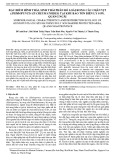


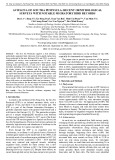

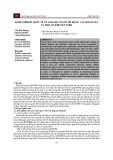
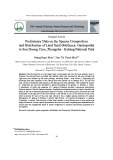
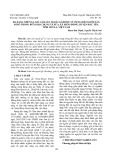

![Đề thi Vi nhân giống có đáp án - Trường TCDTNT-GDTX Bắc Quang (Đề số 2) [Mới nhất]](https://cdn.tailieu.vn/images/document/thumbnail/2023/20230712/nguyenducthang2001/135x160/8951689149552.jpg)















